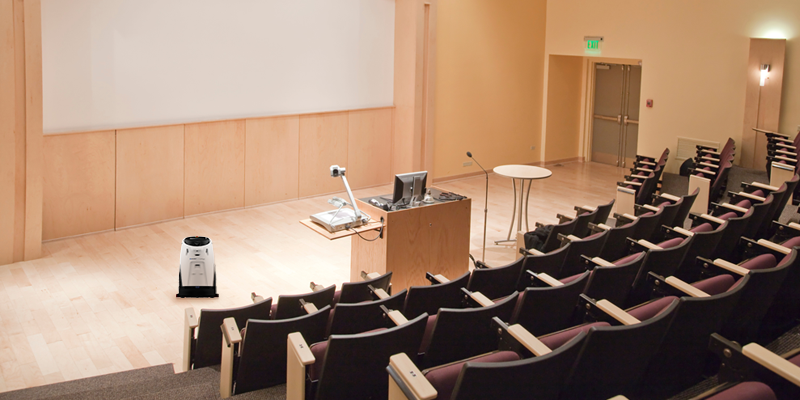
Service robots are becoming commonplace across an incredible number of industries and applications. In this blog, we explore the fundamentals of these innovative automated solutions, highlight some successful applications, and explain their multi-faceted value in the example case of cleaning operations.
What Are Service Robots?
Service robots are robots designed to “serve” humans by taking on tasks that are monotonous, time-consuming, repetitive, and injury-inducing for human workers. Service bots can also be an ideal choice for remote locations, night shifts, and other working conditions that are simply inconvenient for human workers.
Many service bots work autonomously, without human supervision, while offering options for human workers to provide manual direction. Others are “semi-autonomous” and rely on human support to program new tasks. In other words, service robots aim to amplify your existing human staff’s efforts. By offloading time-consuming, low-engagement tasks to service robots, your staff will have time to accomplish work that is more fulfilling and has a higher touch, all while meeting and optimizing current operating procedures.
Compared to a typical industrial or manufacturing robot, service robots are typically mobile, can accommodate a more flexible range of tasks, and are more suited to working in close proximity with even untrained staff, customers, and guests.
How Do Service Robots Work?
Given the huge variety of applications outlined below, many service robots feature unique tools for their intended use case (such as service robots designed to vacuum, floor scrub, or perform multiple tasks). However, a list of common capabilities helps illustrate the technologies behind service robots' capabilities.
- Camera systems and other sensors help service robots navigate through their physical environment, avoiding obstacles and humans dynamically.
- Robots can be programmed to work on a customizable schedule (and, if mobile, transit a set path) while also responding to dynamic occurrences such as guests entering the area, obstacles, spills, or other issues.
- A control system allows a robot to work safely as a “cobot” in close proximity to human workers and guests.
- Human-facing I/O, such as a screen or mobile phone app, allows workers to give orders, alter work routines, or set the robot’s schedule.
- Some robots must be periodically recharged by human workers, while others can autonomously charge using an integrated charging system.
- Data and reporting platforms capture the service robot’s operations, help manage robot fleets, and provide proof of performance.
- Some robots may be deployed in a specific area to work autonomously, while others can be easily transported to work where needed in collaboration with human staff.
As the examples below illustrate, these flexible core capabilities allow service robots to perform admirably in a range of commercial environments.
Examples of Commercial Service Robotics
Promising use cases for service robotics are growing every day, particularly in commercial applications. The examples below illustrate how service robots can take on the most taxing tasks for humans across a number of different settings and operating conditions.
- Data-gathering robots are an ideal fit for the long hours and constant attention required for effective data gathering in a store, public accommodation, or other setting.
- Restaurant service robots can help wait staff, chefs, and bartenders tend to customers more effectively by automating table bussing and ordering.
- Hotel robots are an ideal fit for work, as they can man information desks at odd hours, greet guests, and transport luggage. We take a deeper look at hotel automation here.
- Retail service robots can cruise store aisles to correct shelving errors, execute price changes, and check inventory levels, freeing up human staff to focus on customer interactions.
- Cleaning robots are capable of taking on an array of routine cleaning tasks such as scrubbing, vacuuming, and sanitizing.
Service robot adoption is accelerating because these solutions have proven their ability to support multi-faceted advantages for the operations where they are employed.
Advantages of Using Service Robots for Cleaning Operations
Cleaning operations provide a great illustration of why service robots are so valuable. There is no shortage of repetitive work, hiring remains a chronic challenge for many janitorial and maintenance teams, and robots can drive exceptional value by helping workers clean as efficiently and effectively as possible. For guests and customers, cleaning robots can even help enhance the perception of a sanitary, proactively managed, and innovative space.
Improved Resource Management
Cleaning robots provide unique opportunities to employ cleaning resources more efficiently. For example, a robot can detect messes like spills to clean only when necessary during a low-traffic period, reducing the demand on janitorial staff (for example, during late-night cleaning in a hotel lobby).
With integrated data analytics and forecasting, some cleaning robots can even contribute directly to a more granular long-term understanding of cleaning operations.
Consistent Work Output
A robot is capable of executing tasks with high-precision repeatability. This capability not only ensures predictable results but also reduces the need for inspections, quality control, and supervisor training. Robots also provide a perfectly consistent schedule, ideal for high-traffic areas like lobbies, hallways, and waiting rooms that require continuous, high-frequency recleaning.
Amplify Worker Productivity
Cleaning robots can directly boost workflow efficiency while indirectly driving additional value by freeing up human workers for more creative, sensitive, and complex tasks. Service robots can complement human staff while helping address rising labor market challenges, including absenteeism and disengagement.
Protect Worker Health and Safety While Boosting Morale
By taking on highly repetitive tasks, service robots can reduce the risk of occupational injuries for human staff. The U.S. Bureau of Labor Statistics reported over 21,000 nonfatal injury and illness cases from janitors and business cleaners in 2020. As service cleaning robots take on tasks, such as vacuuming and mopping, that require repetitive motions, maintenance teams will likely see a reduction in days away from work due to injury.
Additionally, by addressing the most monotonous and undesirable tasks, robots can even improve engagement and boost employee morale.
How To Successfully Adopt Service Robots into Your Business
How can a business with limited past robotics experience adopt service robots? A thoughtful implementation process is the best way to move forward. Here’s how our service-based approach drives successful adoption:
- Before launching your service robots program, we conduct a thorough onboarding, taking the time to identify risk factors, KPIs, necessary training, and a proactive preventive maintenance strategy.
- Then, we support the launch of your service robots by communicating with both internal and external stakeholders about this new technology, how it works, and how it will amplify (not replace) human labor.
- Our customers can also capture current performance and maximize ROI using SoftBank Robotics Connect, our proprietary data and reporting platform, which can track robot performance over time, evaluate where they can have the greatest impact, and pursue continuous improvement in both efficiency and cleaning outcomes.
- Finally, we work with our customers to maintain ongoing strategic guidance, unlock new efficiencies as your robotics program matures, and draw on time-saving resources (like FAQs, our robust help center, and expert technical customer support for those new to automation).
With the right practices in place, your service robots will be positioned to earn the greatest possible ROI, streamline cleaning operations, and help your staff accomplish more than ever before.
Transform How You Work With the Trusted Service Robotics Provider
As we have explored in this article, service robots offer incredible potential and flexibility, and the greatest challenge for most organizations is simply developing the right implementation strategy.
SoftBank Robotics offers the full array of services needed to help businesses get the most out of our cleaning robots, including all of the adoption support elements outlined above. As part of our white-glove services offering, you will receive the training you need to hit the ground running, deployment and onsite service assistance, and a repairs and replacement program designed to minimize downtime.
Ready to learn more about how our service robotics program can help support a successful implementation? See what our integrated services can do for you.






